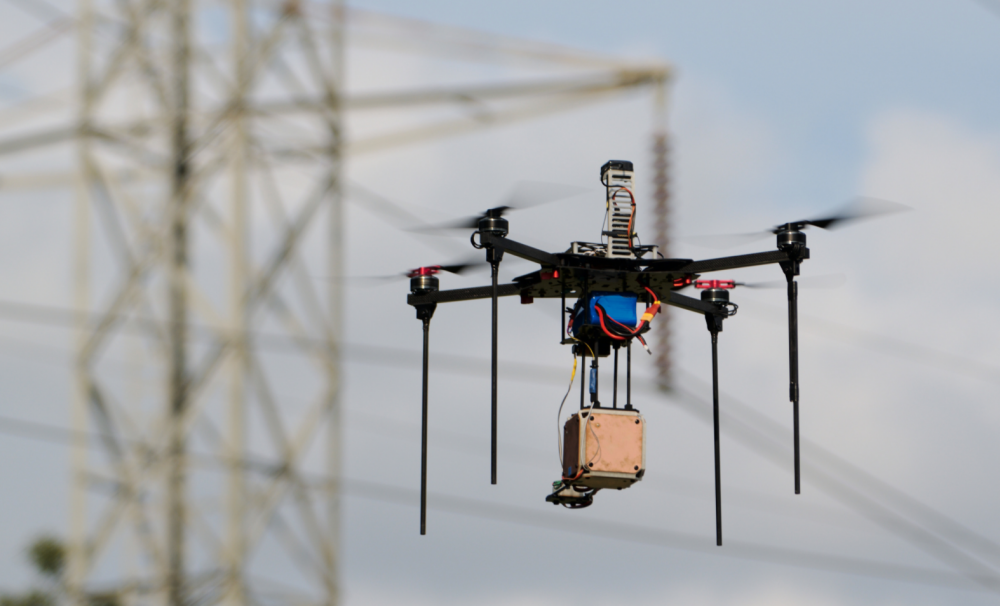Manifold Robotics has announced an agreement with the New York Power Authority (NYPA), the nation’s largest state public power organization, to develop unmanned aircraft systems (UASs) capable of operating safely near power lines.
With partial funding from the New York State Energy Research and Development Authority (NYSERDA), under this project, new sensing technologies and algorithms will be developed and commercialized to enable UAS to detect, avoid, or autonomously track along transmission lines using the electromagnetic fields (EMF) that they emit. The EMF naturally produced by all energized transmission lines will enable UASs to safely traverse electric utility right-of-ways with improved locational awareness of power lines.
Utilities around the world have begun using UASs for such power line inspections as a replacement for helicopter-based methods. Helicopters can be noisy, expensive and potentially risky. However, operating in environments with transmission lines presents significant operational challenges as high electromagnetic fields tend to destabilize conventional UAS navigation systems. In addition, the low visibility of power lines impacts situational awareness of UAS operators thus greatly increasing the chances of collisions with lines and associated structures.
Manifold Robotics is developing a sensor-based detection method for identifying energized power lines in the vicinity of an unmanned aircraft. Based on technology originally developed by the U.S. Army that spun off from a Department of Defense-sponsored proof-of-concept project at New York University, the technology enables UASs to sense EMF from transmission lines at a distance. Through Manifold Robotics, the team is now working to continue developing and fine-tuning the technology for UAS-based commercial applications
“The Power Authority and other utilities around the country can significantly benefit from being able to fully integrate unmanned aircraft systems into inspections of power lines and transmission towers,” said Alan Ettlinger, NYPA’s director of Research, Technology Development & Innovation. “This technology will enable drone aircraft to track along and avoid hitting power lines, even when used beyond the visual line of sight. This will result in increased cost savings and improved reliability over conventional radar or laser-based systems.”
NYPA’s role in the project includes participation in various aspects of design, build and testing of the EMF sensing technology.
“We’re very excited to be collaborating with the team at the New York Power Authority on this important technology development. With this new power line sensing technology, we expect that the full potential of UASs will finally be realized for power line inspection and measurement,” said Jeff Laut, CEO at Manifold Robotics.
With this new technology, Manifold intends to create a UAS-based system that removes major safety and cost issues for the utility industry’s power line inspection effort. In addition, Manifold Robotics anticipates the technology to enable beyond visual line of sight (BVLOS) operations allowing power line inspection to be conducted autonomously.
“NYSERDA is proud to invest in this novel solution to make aerial drones a safe, reliable, and ubiquitous tool for performing power line inspections for a 21st century electric grid. Congratulations to Manifold Robotics and NYPA on this collaborative opportunity to develop and demonstrate the value that innovative technology can bring to New York’s electric system operators,” said Doreen M. Harris, Acting President and CEO, NYSERDA.
Funding for this project is provided by NYPA and NYSERDA through its Electric Power Transmission and Distribution High Performing Grid Program, which makes investments in research and development that accelerate the realization of an advanced, digitally enhanced and dynamically managed electric grid. While the pandemic response delayed the initial start of the commercialization program, the Manifold Robotics team has now launched its product development effort, which is expected to last about 24 months.
“Our intent is that the cost and reliability improvements of our technology will be a timely benefit for energy utilities,” Laut projected.

